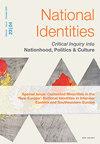Nation-building and mass schooling of ethnic minorities on the Romanian and Soviet peripheries (1918–1940): a comparative study of Bessarabia and Transnistria
IF 0.7
Q3 POLITICAL SCIENCE
引用次数: 0
Abstract
ABSTRACT The paper examines the local responses to mass schooling in the rural areas of Romanian Bessarabia and Soviet Transnistria (1918–1940). Both Romania and the USSR aimed at deeply transforming the local populations. Romania implemented schooling to assimilate ethnic minorities within the model of a nationalizing state, while the USSR adopted an inconsistent nationalizing policy, determinedly imposing compulsory education for all children. The resistance to schooling among ethnic minorities was less intense in Transnistria than in Bessarabia. In both cases, the state authorities abandoned, in the late 1930s, the schooling in minority languages for the benefit of the titular nationalities. Trial registration: Netherlands National Trial Register identifier: ntr-.罗马尼亚和苏联边缘地区少数民族的国家建设和大规模教育(1918-1940):比萨拉比亚和德涅斯特河沿岸的比较研究
本文考察了罗马尼亚比萨拉比亚和苏联德涅斯特河沿岸农村地区(1918-1940)对大规模学校教育的当地反应。罗马尼亚和苏联都旨在深刻改变当地人口。罗马尼亚在国有化国家的模式下实施学校教育以同化少数民族,而苏联采取了不一致的国有化政策,坚决对所有儿童实行义务教育。德涅斯特河沿岸少数民族对学校教育的抵制没有比萨拉比亚那么强烈。在这两种情况下,国家当局在20世纪30年代末为了名义上的民族的利益而放弃了少数民族语言的教育。试验注册:荷兰国家试验注册标识符:ntr-。
本文章由计算机程序翻译,如有差异,请以英文原文为准。
求助全文
约1分钟内获得全文
求助全文
来源期刊

NATIONAL IDENTITIES
POLITICAL SCIENCE-
CiteScore
1.70
自引率
0.00%
发文量
37
期刊介绍:
National Identities explores the formation and expression of national identity from antiquity to the present day. It examines the role in forging identity of cultural (language, architecture, music, gender, religion, the media, sport, encounters with "the other" etc.) and political (state forms, wars, boundaries) factors, by examining how these have been shaped and changed over time. The historical significance of "nation"in political and cultural terms is considered in relationship to other important and in some cases countervailing forms of identity such as religion, region, tribe or class. The focus is on identity, rather than on contingent political forms that may express it. The journal is not prescriptive or proscriptive in its approach.
 求助内容:
求助内容: 应助结果提醒方式:
应助结果提醒方式:


